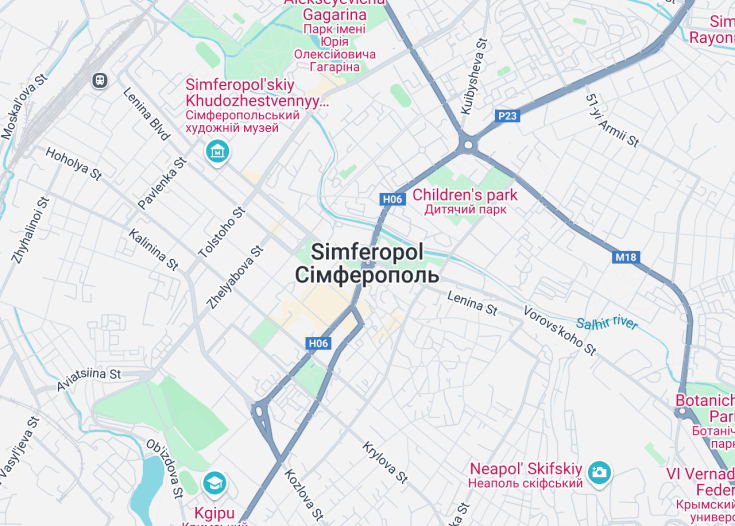Simferopol, the capital of the Republic of Crimea, serves as a vibrant gateway for explorers drawn to this historic peninsula. The city blends a rich tapestry of cultural influences, reflecting its diverse historical legacies. Visitors can enjoy a range of attractions, from lush parks and museums to traditional markets and modern theaters. The city’s transport links make it an ideal starting point for journeys across Crimea, promising an enriching travel experience filled with natural beauty and historical discovery. Simferopol’s warm hospitality ensures a welcoming stay for all who venture here.
Ensure to experience the scenic Salgir River running through Simferopol. A leisurely walk along its banks offers a peaceful retreat from the bustling city life.
Explore the local cuisine by visiting a Crimean Tatar café. Sampling traditional dishes such as chebureki and lagman will enrich your understanding of the region’s cultural heritage.
Top things to do & see in Simferopol
Select the following sights and activities to discover best tickets and tours available in Simferopol.
Simferopol: A Crossroad of Cultures
| Country | Russia |
| Time in Simferopol | GMT+3 |
| Language spoken | Russian |
| Population | 340,600 (2021 Census) |
| Currency | Russian Ruble (₽, RUB) |
| Airports | Simferopol International Airport (12 mi / 19 km). |
Simferopol, the capital city of Crimea, serves as a significant cultural, political, and economic center. Located on the Salgir River and surrounded by beautiful landscapes, Simferopol is a city that bridges the historical narratives of multiple cultures, from Greek and Ottoman to Russian. Historically known as the capital of the Crimean Khanate in the 15th century, the city evolved significantly under Russian rule after 1784. Simferopol played a crucial role during WWII and has been central to political dynamics in the region following Crimea’s annexation by Russia in 2014.
Where is Simferopol?
Simferopol is located in the heart of Crimea, on the northern part of the Crimean Peninsula.
Distances:
| Route | Distance by car | Time by car |
|---|---|---|
| Moscow to Simferopol | 1378 km | 18 hours 30 mins |
| Saint Petersburg to Simferopol | 1967 km | 26 hours |
| Kazan to Simferopol | 1692 km | 22 hours 15 mins |
What is Simferopol famous for?
Simferopol is renowned for its rich history and cultural diversity. It is often considered a hub for accessing various scenic locations across Crimea, making it a strategic transit point for tourists exploring the peninsula.
History
Prehistoric Period – Ancient Times
Simferopol, a city with a rich tapestry of history, traces its roots back to early settlers during the prehistoric period. Archaeological findings in the area reveal traces of Scythian presence, who inhabited the region before it became part of the Greek Empire. By the time the Greeks arrived, they founded the city of Scythian Neapolis, which served as a major cultural and political center from the 3rd century BC until its destruction by the Goths in the 3rd century AD.
3rd Century AD – 18th Century
After the fall of Scythian Neapolis, the region came under the influence of various empires, including the Byzantine and Ottoman Empires. Despite its prominence in ancient times, the area remained relatively quiet until the Crimean Khanate took control in the 15th century. During this period, the city was known as Ak-Mechet, signifying ‘White Mosque’, reflecting the Khanate’s influence.
1784 – Present
The modern era of Simferopol began in 1784 when Catherine the Great annexed Crimea, and the city was re-founded as Simferopol. It became a melting pot of cultures and a significant administrative center in the region. Throughout the 19th and 20th centuries, Simferopol experienced rapid growth and development, particularly in the Soviet era, when it became the capital of the Crimean Autonomous Soviet Socialist Republic. Despite various challenges, including its geopolitical status in recent years, Simferopol continues to be a central cultural and economic hub in Crimea.
Visit Simferopol
What to see and do in Simferopol
Simferopol offers a glimpse into both its ancient past and vibrant modern life. Visitors can explore the Scythian Neapolis archaeological site, which provides insights into the ancient Scythian civilization. The Simferopol Art Museum, featuring Russian and Ukrainian art, and the Crimean Ethnographic Museum are also must-visit places for culture enthusiasts. For a dose of nature, the Salgirka City Park offers a serene escape with its old trees and calm river. (ul li)Scythian Neapolis Archaeological Site(/li li)Simferopol Art Museum(/li li)Crimean Ethnographic Museum(/li li)Salgirka City Park(/li /ul)
Annual Events in Simferopol
Simferopol is host to several cultural and historical events throughout the year. The Crimea Music Fest, held in early September, features a variety of music genres and attracts performers from across Eastern Europe. Another significant event is the Simferopol International Film Festival, which takes place in late October, showcasing films from around the world and promoting local cinema.
Best time to visit Simferopol
The best times to visit Simferopol are during spring (April to June) and early autumn (September to October). These months offer mild weather, making it pleasant to explore the city’s outdoor attractions and partake in local events.
Is Simferopol worth visiting?
Simferopol is a destination that offers a complex blend of historical depth and cultural richness, making it appealing for history buffs and cultural enthusiasts alike. The city’s archaeological sites and museums provide deep insights into the region’s past, while its parks and natural surroundings offer tranquil retreats. However, visitors might find challenges regarding accessibility and international travel restrictions due to the geopolitical situation. Understanding these factors is essential when planning a visit, but for those intrigued by its history and culture, Simferopol is certainly worth considering.










